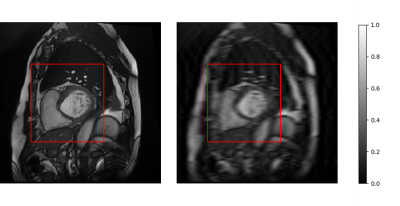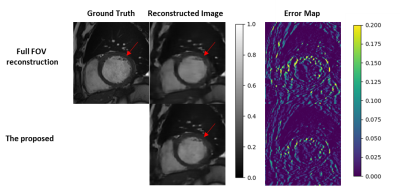3601
Rapid Region-of-Interest MRI Reconstruction Using Context-Aware Non-Local U-Net1School of Information Technology and Electrical Engineering, the University of Queensland, Brisbane, Australia, 2School of Information and Communication Technology, Griffith University, Brisbane, Australia
Synopsis
In MRI, region-of-interest (ROI) imaging is frequently used in clinical applications. The sub-sampling-based scheme is capable of accelerating the ROI-focused image reconstruction process but degrades the image quality. The degradation could be alleviated by ROI-weighted optimization; however, existing methods mainly focus on the local signal restoration and have no explicit control of the noise from the entire image. In this abstract, we propose to reconstruct the ROI using a non-local U-net method that incorporates contextual information from the whole image. The results show the proposed algorithm improves PSNR and SSIM over conventional methods.
Introduction
Large field-of-view (FOV) is typically implemented during MRI acquisition to avoid the fold-over artifacts, however, only the region of interest (ROI) is needed for many clinical purposes. For example, cardiac imaging requires a large FOV but only the region containing heart is of the interest[1]. This also applies to prostate imaging, where the whole pelvis MRI scan is needed. The large FOV slows down the acquisition process, leading to motion artifacts and discomfort for the patients. To accelerate the imaging process, less data is sampled and then the de-aliasing algorithm is applied to reconstruct high-quality images. Algorithms that reconstruct the full FOV images are capable of producing good results with high peak signal-to-noise ratio (PSNR) and structure similarity index (SSIM) on the whole images. However, these metrics are normally worse in the ROI. This is mainly because these ‘global’ algorithms optimize the reconstruction for full FOV, rather than the ROI.Earlier works[1, 2] on ROI-specific reconstruction used the weighting techniques to constrain the optimization in the local region during the iterative optimization process. While the ROI-weighted objective function improves image quality, the entire image signal context is not explicitly considered for a further improved result. The contextual information in full FOV images is important to recover the ROI because local area is corrupted by signals leaked from the entire image under Gaussian sub-sampling pattern. In other words, the sub-sampling process inevitably causes local-global interference on the aliased image. The signal interference in the image domain has not been explicitly investigated in previous works, leading to compromised ROI reconstruction quality. In this work, we propose a deep learning-based ROI de-aliasing algorithm, where the local-global signal dependencies are considered using the designed non-local blocks. Results show the proposed method outperforms the full image reconstruction in ROI with increased SSIM and PSNR.
Methods
To reconstruct the ROI image with contextual information, we propose a de-aliasing network that takes the aliased image as input and outputs the reconstructed ROI. The network has a U-net[3] as the backbone with a non-local block[4] inserted in the expanding path, and we name it as non-local U-net. Table 1 shows the configuration of the proposed network architecture.In an aliased image, the signal leakage from one pixel spreads across the whole image. Therefore, the aliased ROI contains signal from the local area and the full FOV image under the Gaussian sub-sampling pattern. To restore the fully-sampled ROI, all pixels in the full image domain need to be explicitly considered. Inspired by the idea of non-local means in image denoising, a non-local block[4] is designed to include all pixels in the operation. The non-local block is shown in Figure 1 and can be expressed as: $$$y_{i}= \frac{1}{C(x)}\sum\limits_{∀j}f(x_{i},x_{j})g(x_{j})$$$, where $$$x$$$ is the input feature, $$$y$$$ is the output feature, subscription $$$i$$$ and $$$j$$$ are index positions of pixels, $$$f(x_{i},x_{j})$$$ is the embedded Gaussian function describing the similarity between two pixels, $$$g(x_{j} )=W_{g} x_{j}$$$ is a representation of input where $$$W_{g}$$$ is to be learnt in the training process, and $$$C(x)$$$ is the normalization factor. We can see for a specific pixel $$$x_{i}$$$, the output $$$y_{i}$$$ comes from the calculation of all pixels.
Results and Discussion
We used the ACDC dataset[5] to train and test the proposed algorithm. 395 two-dimensional slices of high quality were selected from 50 subjects. We randomly split the dataset into 320 slices for training and 75 slices for testing and reporting results. The image was resized to 256-by-256, and the intensity was normalized to 0~1. We simulated the one-dimensional Gaussian sub-sampling process with acceleration rates of 6 by applying the corresponding binary mask to k-space. Figure 2 shows the ground truth image and the zero-padded image. The red square denotes the ROI.We evaluate the algorithm on the testing set and report average results in this section. PSNR and SSIM are used to evaluate the reconstruction results on ROI. We conducted two experiments to show the effectiveness of the proposed algorithm. Firstly, we trained the full FOV images using U-net that outputs the full FOV and evaluated the results only on the ROI containing a heart. The second test was conducted on the proposed method, which outputs the ROI. The qualitative comparison between the two tests is shown in Figure 3, and the quantitative comparison is shown in Table 2. We can see the introduction of one non-local block improves the image quality of ROI reconstruction.
Conclusion
We have proposed a ROI MRI reconstruction method using a non-local U-net incorporating context information of the full FOV image. The proposed algorithm achieves improved SSIM and PSNR in the ROI reconstruction compared to the conventional full FOV reconstruction.Acknowledgements
No acknowledgement found.References
[1] A. S. Konar et al., "Region of interest compressed sensing MRI," Journal of the Indian Institute of Science, vol. 94, no. 4, pp. 407-414, 2014.
[2] L. Sun, Z. Fan, X. Ding, Y. Huang, and J. Paisley, "Region-of-interest undersampled MRI reconstruction: A deep convolutional neural network approach," Magnetic resonance imaging, vol. 63, pp. 185-192, 2019.
[3] O. Ronneberger, P. Fischer, and T. Brox, "U-net: Convolutional networks for biomedical image segmentation," in International Conference on Medical image computing and computer-assisted intervention, 2015: Springer, pp. 234-241.
[4] X. Wang, R. Girshick, A. Gupta, and K. He, "Non-local neural networks," in Proceedings of the IEEE Conference on Computer Vision and Pattern Recognition, 2018, pp. 7794-7803.
[5] O. Bernard et al., "Deep learning techniques for automatic MRI cardiac multi-structures segmentation and diagnosis: Is the problem solved?," IEEE Transactions on Medical Imaging, vol. 37, no. 11, pp. 2514-2525, 2018.
Figures




